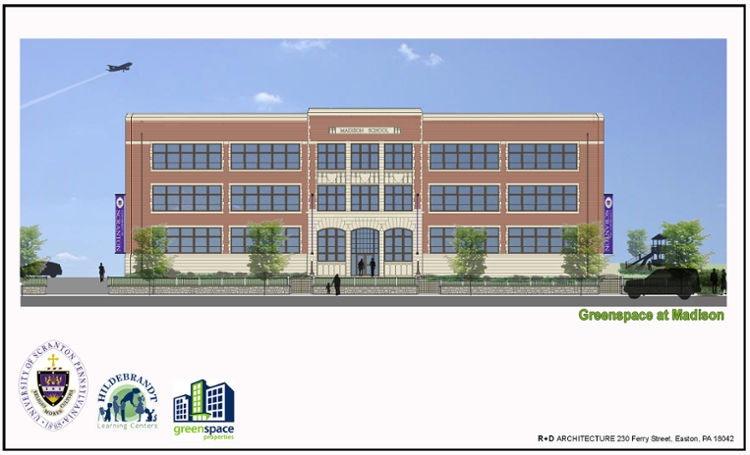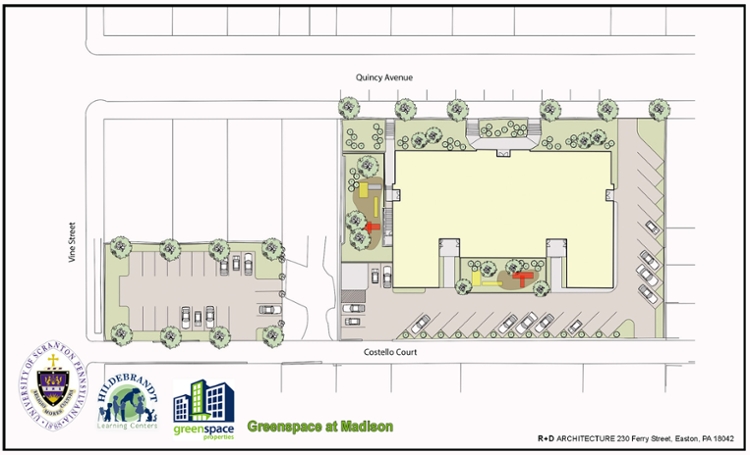Collaborative Partnership will Revitalize Vacant Hill Section School

The University of Scranton, Greenspace Properties and Hildebrandt Learning Centers announced a project to convert the former Madison Junior High School building at 528 Quincy Avenue into a state-of-the-art learning center and apartment-style housing to serve the University’s growing population of graduate and international students.
A former junior high school in Scranton’s historic Hill Section will get new life through a unique project that will revitalize the now vacant structure into an early childhood learning center and graduate student housing.
On Thursday, Dec. 18, The University of Scranton, Greenspace Properties and Hildebrandt Learning Centers announced a project to convert the former Madison Junior High School building at 528 Quincy Avenue into a state-of-the-art learning center that can accommodate approximately 120 children and apartment-style housing with 24 apartments to serve the University’s growing population of graduate and international students.
Built in the early 1900s, the 43,000 square foot, three-story building is listed on the National Park Service’s “National Register of Historic Places.” It will be renovated using local and environmentally friendly materials and low energy systems. Although the original school was tax exempt, the renovated property will now be added to the tax rolls because it will continue to be owned by the private developer.
“The University of Scranton is delighted to be part of this exciting project that will preserve and repurpose a beautiful example of our City’s historic architecture, expand much-needed learning center options for families, and address our need for additional student housing, especially at the graduate level,” said University of Scranton President Kevin P. Quinn, S.J. “We are especially pleased and grateful to partner with two companies with outstanding expertise and deep roots in our region.”

Greenspace Properties is a West Pittston-based real estate development firm owned by Clifford K. Melberger, who also served as chairman of Diversified Information Technologies. Greenspace acquired the property in 2008 and subsequently developed an initial vision for its use in conjunction with R+D Architecture and Martin Rogers Engineering Consultants. The firm successfully sought and received an Economic Growth Initiative grant from the Commonwealth of Pennsylvania to support renovations.
“When we acquired this building, we saw such tremendous potential for it to once again be an attractive and important part of the neighborhood,” Melberger said. “Through our collaboration with the University and Hildebrandt, we are announcing a project that surpasses all of our initial expectations.”
Following discussions with the University that began in the summer, the scope of the project was expanded to include an early childhood learning center and a housing configuration that is comparable to the University’s other apartment-style offerings.
“We know that our faculty and staff continue to seek high quality options for their children that are close to campus,” said Edward Steinmetz, senior vice president for finance and administration. “We are confident that Hildebrandt Learning Centers is an ideal partner for this aspect of the project, which will also be available to the broader community.”
Based in Dallas, Hildebrandt Learning Centers (HLC) currently manages 45 centers and employs over 1,000 early childhood educators. The new center will follow HLC’s well-established approach that encourages development and learning of each child through age-appropriate curriculum, play, individualized assessments and nurturing relationships.
“We are committed to fostering meaningful relationships with the children and families in our programs and creating environments that are founded on early care and learning community standards that are the best practices in our profession,” said William J, Grant, Chief Executive Officer, Hildebrandt Learning Centers. “We also have excellent experience working with higher education institutions, including King’s College and Penn State University, to create unique avenues for student and faculty collaboration through internships and experiential learning opportunities.”
The learning center will be located on the first floor of the three-story building. The second and third floors will be converted into one-, two- and three-bedroom apartments that will be operated by the University and used primarily for graduate students.
The adaptive reuse of the Madison School consists of new roofs, windows, energy-efficient HVAC systems and light fixtures, fire protection and security systems, retaining walls, fencing, onsite parking, landscaping and age-specific playgrounds for the learning center.






